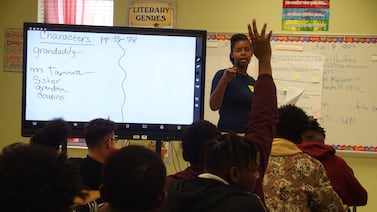This story about eighth grade algebra was produced by The Hechinger Report, a nonprofit, independent news organization focused on inequality and innovation in education. Sign up for the Hechinger newsletter.
BRAHAM, Minn. — It was fourth-period Basic Algebra 8 class on a gray October morning at Braham Area High School. Teacher Rick Riccio had assigned an exercise on converting large integers to scientific notation, but fifteen minutes in, some students had lost focus. Two girls at a back table sang, their worksheets empty. Two boys pulled up games on their laptops, as two other girls discussed what they’d name their children someday.
Riccio tried to reel them in as he walked around answering questions. “You’re a little too crazy today,” he said to the girls in the back. “You gotta settle down and get this done.”
Not all eighth graders are ready for the abstract concepts — like variables, linear functions, slope — that come with Algebra 1, some experts and teachers say. Those more complex ideas also require extended concentration, which is difficult for many middle schoolers.
“Eighth grade, they’re just in full-on puberty, hormones,” said Zach Loy, another math teacher at the high school, an hour’s drive from Minneapolis. “Are they capable of sitting down and focusing on one thing for two, three minutes at a time without getting distracted? I see that as being the hardest barrier.”
But under a 2006 Minnesota law designed to boost the number of students going into math and science careers, all eighth graders were required to take Algebra 1. At the time, legislators argued that getting more kids through algebra before starting high school would ensure they were on a path to graduate having taken calculus, often seen as a gateway for entry to selective colleges and to well-paying jobs in fields like engineering and medicine.
There was a logic behind that: In a traditional course sequence, finishing calculus is easier if students take Algebra 1 by eighth grade since they can continue on to geometry, Algebra 2, precalculus or trigonometry, and then calculus their senior year.
But a Hechinger Report analysis of federal data shows Minnesota’s law hasn’t worked out as planned. Between 2009 and 2017, the share of the state’s students taking calculus did rise modestly, from 1.25 to 1.76%. But other states saw far larger gains, and Minnesota dropped from sixth to 10th place among states for calculus enrollment as a share of total enrollment. (2017 is the latest year for which there are compiled federal data on calculus enrollment, according to U.S. Department of Education spokesperson Alberto Betancourt.)
On the National Assessment of Educational Progress, a national test done every two years, Minnesota fell from second place among the 50 states in 2009 on eighth grade math scores to eighth place in 2022, the latest year of available data.
Braham and other districts report that there’s been no change in the number of their students taking calculus, in part because many students just aren’t interested in STEM-heavy careers, administrators say. In addition, state education leaders responded to the 2006 mandate by introducing a policy in 2007 that enabled students to take Algebra 1 over two years instead of one, neutralizing the effect of starting the course earlier.
In many school districts around the country, algebra has become a hot button issue, with some parents pushing their kids to take it in eighth grade — and school districts to offer it then — because of the opportunities it may unlock in high school and beyond. But the share of students in eighth grade algebra who are Black or Hispanic has remained low. A few districts have tried eliminating the eighth grade algebra option altogether as a way to increase equity and get rid of separate advanced and standard math tracks, stirring parent opposition.
Minnesota went the opposite route, effectively giving students the same opportunities by placing everyone on an accelerated track. Its experience suggests early universal algebra isn’t a cure-all for boosting the share of students in advanced math.
“That replicates what most of the studies have found,” said Scott Peters, senior research scientist at educational assessment organization NWEA. Early algebra does appear to slightly boost enrollment in advanced math courses in the short term — for example, more 10th graders taking Algebra 2 — but the effect fades as students get older, he said.
And there could be a downside. A 2015 study found that a brief experiment by California to enroll all eighth graders in algebra backfired, lowering test scores in large districts, though it had little effect on small and mid-sized ones. “If you push a kid too far, too fast, they might be either less interested or feel defeated or it hurts their self-efficacy and confidence in math,” study co-author Andrew McEachin said.
Taking algebra early seen as key step toward calculus
The roots of universal eighth grade algebra go back to the late 1990s, when policymakers began promoting it to get more students through calculus in high school. That, in turn, would boost their college and career chances — especially for Black and Latino students and those from low-income households — and help U.S. competitiveness, went the thinking. Between 2000 and 2005, the share of U.S. eighth graders enrolled in algebra shot up from 27% to 42%, according to the Brookings Institution. (By 2020-21 it was less than 24%, according to the U.S. Department of Education.)
Minnesota legislators took notice. In 2006, a state education bill required for the first time that the state’s eighth graders take Algebra 1, starting in the 2010-11 school year. “I remember people saying they wanted to make sure students could complete algebra, geometry, trigonometry, and calculus in high school,” said former state Sen. Steve Kelley, the bill’s co-author. “To do that, we needed to have them take Algebra 1 in eighth grade.”
Related: Is calculus an addiction that college admissions officers can’t shake?
Many math experts warned against the move. “This whole idea is a very naive belief that if we just kind of make it for everybody, everyone will learn,” Brookings education researcher Tom Loveless told the St. Paul Pioneer Press in 2008. That same year the National Council of Teachers of Mathematics recommended against mandating Algebra 1 at a prescribed grade level. “Exposing students to such coursework before they are ready often leads to frustration, failure, and negative attitudes toward mathematics and learning,” the group wrote.
But Minnesota kept universal algebra in eighth grade and to date is the only state that’s adopted and stuck with the policy. California mandated its plan in 2008 but reversed course in 2010 after a court-ordered postponement and pressure to adopt the Common Core standards, which recommended that eighth graders take pre-algebra, not algebra. About 6.4% of school districts around the country, most of them in Minnesota, report having policies mandating algebra in eighth grade.
Many students still shy away from calculus
At Braham and other Minnesota districts, the algebra-to-calculus pipeline hasn’t materialized. In some districts, not many students head into careers that require calculus, and that’s been true both before and after the mandate, said district leaders. Most students pursue fields in which calculus isn’t needed, like nursing, education, business, or dental hygiene, said district social worker and career advisor Staci Kuhnke. Isanti County, where Braham is located, has about 70 manufacturers, an energy company headquarters, a hospital, and a community college.
This year, in a senior class of 47 students, just one is taking calculus, through an arrangement with a local community college, she said. Most students do not take a math course their senior year.
Related: Is it time to stop segregating kids by ability in middle school math?
Braham ninth grader Savannah Gudilias, 14, said she wished she’d waited till ninth to start Algebra 1. She struggled so much that it hurt her confidence in math. “I didn’t understand it and still don’t,” she said. She wants to be a nurse. “Actually, that takes too much math,” she said. “Maybe a teacher. But not a math teacher.”
Caden Rivera, a 16-year-old junior, said middle school was the beginning of a math slide for her. She got As in elementary school math but her grades fell once she hit algebra in eighth grade. “I was just really immature and didn’t pay attention,” she said. “And I needed more time — some people learn slower and others faster.” After high school she wants to get a culinary degree and knows she’ll need more math, but she has no interest in calculus.
Others are doing well in the course. Sean Oldenburg, an eighth grader, wants to someday get a job at the BNSF Railway Company, where four generations of his family have worked. He thinks he’ll pursue an engineering degree, which would mean he’d take calculus in high school. Algebra 1 in eighth grade has been a stretch. “I could do multiplication tables, all that stuff great,” he said. “Then you started adding these symbols, and I didn’t get it.” But he’s confident he’ll master it. “It just takes time,” he said.
Many districts lack math teachers, training
When it comes to math, Braham’s leaders have worries that are more basic than getting students to calculus. District scores on state eighth grade math tests have lagged behind the state average most years since 2010. The district, which at fewer than 800 students is small, is 87% white and has a poverty level in the low-to-middle range, with 44% of students getting free and reduced-price lunch.
Ken Gagner has been Braham’s superintendent since 2015. Gagner, trim and graying, is mostly neutral on eighth grade algebra for all — he said it’s good for students to be exposed to increased rigor but worries those who aren’t ready for the course could be turned off to math completely. What the district really needs to address its math gap, he and other administrators said, are more certified math teachers, math tutors to help those struggling and smaller class sizes. Gagner said when the district advertises for math teachers he would be happy “if we would get four applicants.”
Related: Some schools cut paths to calculus in the name of equity. One group takes the opposite approach.
At Pillager Public School District, 100 miles northwest of Braham in another rural town, eighth grade Algebra 1 has played out much the same way. Ryan Krominga, the district director of curriculum and instruction, said the mandate came with little direction from the state. So districts simply took their ninth grade algebra textbook and content and started using it in eighth grade, he said.
Many eighth graders aren’t developmentally ready for the more complex concepts involved in algebra, he said. They don’t get enough time with the concrete elements of math, such as multiplication and division, because there’s pressure to get to algebra so quickly, he added.
“In my experience, it hasn’t worked out,” he said of the requirement. “I haven’t seen that kids have this huge understanding of mathematics or that they’ve increased their algebraic thinking.” And the district has seen no increase in the number of students taking calculus, he said. Some years they don’t offer the class because they don’t have enough students who want it.
Little pressure to change math policy
Not all districts dislike the policy. Jeremy Larson, assistant superintendent of learning and accountability at Moorhead Area Public Schools in the state’s far west, said two years of algebra gives the district flexibility to slow down eighth graders who may have been accelerated too fast into Intermediate Algebra, the second part of the district’s two course Algebra 1 sequence. “If they’re in Intermediate Algebra as an eighth grader and it’s just kind of difficult, we say, ‘Hey, let’s just take a step back,’” said Larson.
And unlike the other two districts, Moorhead’s calculus numbers have increased, though not by much: An average of 1.3% of students in the district were enrolled in calculus in the three years before the eighth grade requirement took effect in 2010. Today it’s about 1.5%, or 13 more students per year in a district with total enrollment of about 6,200.
Related: Data science under fire: What math do high schoolers really need?
The Minnesota Department of Education contends that the state’s drop in calculus enrollment and eighth-grade math scores compared to those of other states isn’t representative of its larger efforts. “These are two of many measures of student success that MDE looks at to guide our support of school communities,” said spokesperson Anna Arkin in an emailed response to Hechinger’s findings. “We are invested in every student receiving a world class education and thriving in school.”
There’s been no pressure to change the mandate. That’s in part because of the 2007 revision legislators made to the state education standards, enabling schools to stretch algebra over two years, said Mike Weimerskirch, associate professor at the University of Minnesota’s School of Mathematics. Weimerskirch said the issue didn’t come up during the latest state committee revision of the math standards. “It’s been long enough now that it’s just kind of become accepted, become part of the culture, and we’ve learned to deal with it,” he said.
Related: Eliminating middle school math ‘tracks’ often sparks outrage. Some districts buck the trend
Back in Riccio’s eighth grade algebra class a day later, slowing down made a difference. Riccio decided that it would be a catchup session because so many students struggled with scientific notation the day before. “Looking at some of these papers that you guys handed in, a lot of you have not gotten this concept,” he said. He went through the procedures again and put up an integer on the whiteboard. “So what is our number then?” he asked.
“Would it be 5 times 10?” offered one student. “Why is it 5? No,” said Riccio, as students started cross-talking. “Everybody pay attention. Everybody quiet. Focus.” He wrote another large integer on the whiteboard. “What if I give you something like this? Any volunteers?”
“Can I try it?” said James Belland, a tall 14-year-old in a red T-shirt. “Jimmy, take a stab at it please,” said Riccio. Belland came to the whiteboard and wrote the conversion.
“You got it Jimmy,” said Riccio. “Everybody give him a round of applause.” The kids clapped and cheered. Riccio put up another problem and asked whether anyone else wanted to try. Ten hands shot up.
“It’s nice when these kids start getting it,” said Riccio afterward.
Contact editor Caroline Preston at 212-870-8965 or preston@hechingerreport.org.
Correction: This story has been updated to more accurately describe the education assessment organization NWEA and to correct the name of the St. Paul Pioneer Press newspaper.
This story about eighth grade algebra was produced by The Hechinger Report, a nonprofit, independent news organization focused on inequality and innovation in education. Sign up for the Hechinger newsletter.




